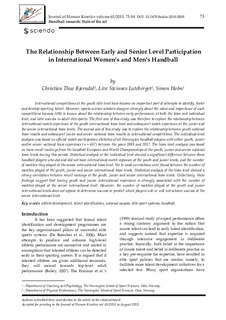| dc.contributor.author | Bjørndal, Christian Thue | |
| dc.contributor.author | Luteberget, Live | |
| dc.contributor.author | Holm, Simen | |
| dc.date.accessioned | 2018-11-01T07:48:17Z | |
| dc.date.available | 2018-11-01T07:48:17Z | |
| dc.date.created | 2018-10-28T16:06:51Z | |
| dc.date.issued | 2018 | |
| dc.identifier.citation | Journal of Human Kinetics. 2018, 63, 73-84. | nb_NO |
| dc.identifier.issn | 1640-5544 | |
| dc.identifier.uri | http://hdl.handle.net/11250/2570489 | |
| dc.description | Open access, CC BY-NC-ND 3.0. You are free to: Share — copy and redistribute the material in any medium or format. The licensor cannot revoke these freedoms as long as you follow the license terms. | nb_NO |
| dc.description.abstract | International competitions at the youth elite level have become an important part of attempts to identify, foster and develop sporting talent. However, sports science scholars disagree strongly about the value and importance of such competitions because little is known about the relationship between early performance, at both the team and individual level, and later success in adult elite sports. The first aim of this study was therefore to explore the relationship between international match experience at the youth international team level and subsequent match experience at the junior and the senior international team levels. The second aim of this study was to explore the relationship between youth national team results and subsequent junior and senior national team results in international competitions. The individual-level analysis was based on official match participation statistics of all Norwegian handball players with either youth, junior and/or senior national team experience (n = 657) between the years 1993 and 2017. The team level analysis was based on team result rankings from the handball European and World Championships at the youth, junior and senior national team levels during this period. Statistical analysis at the individual level showed a significant difference between those handball players who did and did not have international match exposure at the youth and junior levels, and the number of matches they played at the senior international team level. No to weak correlations were found between the number of matches played at the youth, junior and senior international team levels. Statistical analysis at the team level showed a strong correlation between result rankings at the youth, junior and senior international team levels. Collectively, these findings suggest that having youth and junior international experience is strongly associated with the number of matches played at the senior international level. However, the number of matches played at the youth and junior international levels does not appear to determine success or predict which players will or will not achieve success at the senior international level. | nb_NO |
| dc.language.iso | eng | nb_NO |
| dc.subject | athlete development | nb_NO |
| dc.subject | talent identification | nb_NO |
| dc.subject | national squads | nb_NO |
| dc.subject | elite sport systems | nb_NO |
| dc.subject | handball | nb_NO |
| dc.title | The Relationship between Early and Senior Level Participation in International Women's and Men's Handball | nb_NO |
| dc.title.alternative | The Relationship between Early and Senior Level Participation in International Women's and Men's Handball | nb_NO |
| dc.type | Journal article | nb_NO |
| dc.type | Peer reviewed | nb_NO |
| dc.description.version | publishedVersion | nb_NO |
| dc.rights.holder | © 2018 Editorial Commitee of Journal of Human Kinetics | nb_NO |
| dc.source.pagenumber | 73-84 | nb_NO |
| dc.source.volume | 63 | nb_NO |
| dc.source.journal | Journal of Human Kinetics | nb_NO |
| dc.source.issue | 1 | nb_NO |
| dc.identifier.doi | 10.2478/hukin-2018-0008 | |
| dc.identifier.cristin | 1624223 | |
| dc.description.localcode | Seksjon for coaching og psykologi / Department of Coaching and Psychology | nb_NO |
| cristin.unitcode | 150,32,0,0 | |
| cristin.unitcode | 150,31,0,0 | |
| cristin.unitname | Seksjon for coaching og psykologi | |
| cristin.unitname | Seksjon for fysisk prestasjonsevne | |
| cristin.ispublished | true | |
| cristin.fulltext | original | |
| cristin.qualitycode | 1 | |
